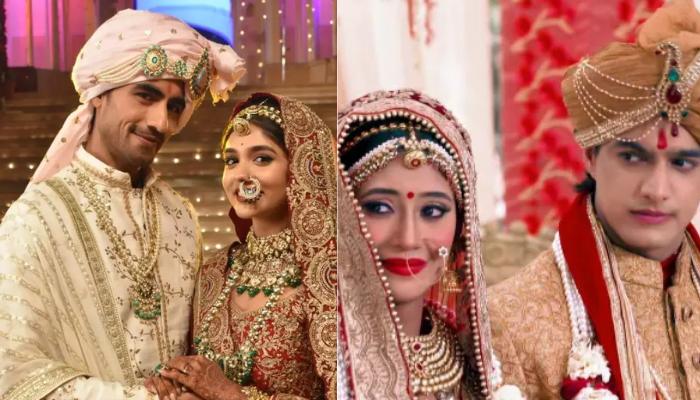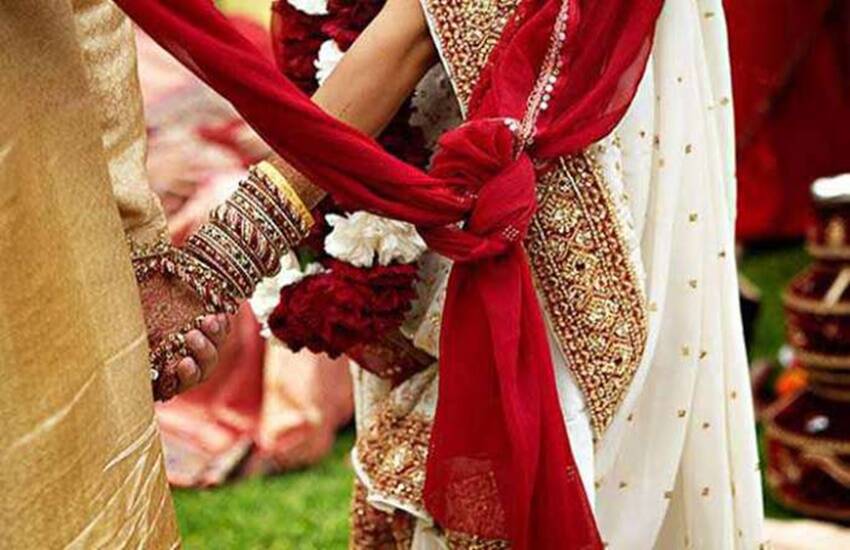About Us
Advertise With Us
RSS Feed | Content Syndication
Terms & Conditions
Privacy Policy
Contact Us
BollywoodShaadis.com © 2025, Red Hot Web Gems (I) Pvt Ltd, All Rights Reserved.

The state of Rajasthan is synonymous with the terms like royalty, majesty, grandeur and heritage. Yet, it is the spirit of the state that makes us go stunned by its extraordinary beauty. Language, food, culture and traditions speak volumes about the vibrant and glorious history of the state. Rajasthan is fragmented into two primary ethnic groups, the Mewar and the Marwar. Both have been a hereditary part of the state’s very own royal lineage and are the repository of distinct culture, taste and tradition in themselves.
The Marwari community is the oldest ethnic group among the others. It can be related to the land of royal warriors, who have recently been popularised as the most successful business group. With its rich culture and traditions, the one other thing which is a crucial part of their customs is their wedding. Exuding sheer imperial vibes, it is a long celebration full of pomp and show. So come along, and decode with us the festivities of a proper Marwari wedding.
Recommended Read: Bengali Wedding Traditions: From Pre-Wedding 'Aadan Pradaan' To Post-Wedding 'Phool Sojja'

The first step of a true-blue Marwari wedding is the tilak ceremony. This usually happens a long time in advance, even before the bride and groom's engagement. It marks the bride's acceptance by the groom’s family and vice-versa. Both the families come together and bless the couple as a mark of acceptance of their union. There is also a lot of exchange of gifts that takes place during the ceremony.

Up next, the families begin preparing homemade sweets out of jaggery and lentils post the finalisation of the wedding date. This is called the byaah haath, which the women of the household usually carry out. Finally, the mothers of both the bride and groom sing holy songs or mangal geet, along with the other womenfolk of the house, and also begin to extend an invitation to their respective families, known as the bhaat nyotana.
Continue reading below

The first invitation to the wedding is given to Lord Ganesha, as both families seek his blessings for a successful and hassle-free wedding and the overall well-being of the new couple. They also seek abundance and prosperity for both the families. To ward off evil forces from the happy festivities, both the households are decorated with hand-painted holy symbols of the om and swastika.

Commonly known as the engagement, the groom and his family visit the bride’s place and officially begin the wedding festivities. While both the families meet and exchange gifts and sweets, the couple, on the other hand, exchange rings with a promise of forever.

Like most other wedding customs, the Marwari wedding also incorporates ceremonies like haldi, which usually takes place in the same manner as others. A fragrant paste of turmeric and sandalwood prepared at the groom’s house is first applied to the groom, and the remaining part is sent to the bride’s place and applied to her. One interesting rule after the haldi ceremony is that both the bride and groom are not allowed to step out of the house until the wedding.

Right after the haldi ceremony, the bride and groom are given a bath of mustard oil and curd, followed by water. They are given special jaggery-made sweets to eat at the end of this, and at this time, the maternal uncles of the bride and groom present them each with shagun or money as a mark of good luck.
Also Read: Decoding Sikh Wedding: Everything You Need To Know About The Sacred Pre And Post Wedding Rituals

The mark of an auspicious bride, the mehndi ceremony is an integral part of a Marwari wedding. While common traditions usually recall only the bride to have worn henna on her hand, it is equally important for the groom in the Marwari traditions to apply it on his hands as well.

A tradition quite typical of a Marwari wedding, mahira dastoor is a ceremony that involves the significant role of the maternal uncle and aunt of both the bride and groom. First, the respective mothers welcome the aunt and uncle to their place and feed them an extravagantly prepared home-cooked meal. This is followed by the maternal uncle and aunt blessing the respective bride and groom along with gifts, clothes and token money. It signifies the importance of maternal relations even after the woman's marriage.

A wedding becomes an excellent time for exchanging gifts of various kinds. Revoking this tradition, a palla-dastoor ceremony includes the visit of the groom’s family to that of the brides, along with decorated presentations of gifts, clothes, sweets, fruits and all things fancy. It is also the time that the groom’s family presents the bride with her wedding trousseau, which she is required to wear at her wedding.

Resembling a night of the party for both the bride and groom, the sangeet brings a traditional twist to the popular idea of a bachelor’s party. Both the bride and groom engross themselves separately in a time of gala and merriment with their friends. They enjoy the night before their wedding singing, dancing and indulging in a massive feast of food.
Check This Out: Beautiful Significance Behind The 'Kanyadaan', The Most Emotional Moment For A Father And Daughter

The day of the actual wedding begins with a thamb puja, which ideally translates as the puja of the house's pillars. The priest from the groom’s family performs this puja at the bride’s home, particularly indicating at the house's pillars. It symbolises the idea of having a solid foundation for marriage, just like the house's strong foundation, which supports the tall and mighty pillars.

A unique tradition in a Marwari wedding korath is the symbolic invitation of the groom and his family to the bride’s place. This is usually done by the male head members of the bride’s family, who visit the groom and his family and invite them to the wedding mandap. Again, a lot of exchange of gifts, token money and clothes take place at this moment.

A sister is an integral part of life for the brother, and the nikaasi ceremony elaborates one such bond. As the excited groom gets ready to step into a new stage of his life, the sister helps him get ready for the big day as she lovingly ties the pagdi or sehra on his head. She also ties a sacred thread on his arm to ward off evil eyes.

As the groom proceeds towards the bride’s place with his baraat or wedding procession, he is welcomed with much grandeur and love by the bride’s mother. She does an arti of the groom, blesses him and feeds him sweets, fondly. The groom is then expected to touch the toran or the decorative arch tied high above the gate of the venue with a stick of the neem tree in order to proceed to the wedding.

As the groom enters and settles down, the bride is brought in shortly to the mandap. Then, as the bride and groom please their eyes with each other’s much-awaited look in wedding attire, they proceed by exchanging floral garlands or jaimala.
Check This Out: 'Saat Pheras' In A Hindu Wedding: Importance, Relevance And Meaning Of Each 'Phera'

Just after the jaimala, the bride and groom’s respective sister steps in to tie the gathbandhan, which signifies their union. One end of the bride’s dupatta is tied in a tight knot with one end of the groom’s waist cloth, which is then placed on the groom’s shoulder.

Like most other Hindu wedding rituals, the kanyadaan is the top moment of a Marwari wedding, which translates to the giving away of the daughter to the groom. This moment is symbolic of the countless promises the groom gives to the bride’s father, as he vows to take responsibility for his daughter and accept her as his wife.

During this moment, the bride and groom take seven rounds around the sacred fire while the priest chants the holy scriptures. Additionally, in each of her rounds, the bride pushes a grinding stone with her feet, symbolising the removal of obstacles in their marriage.

The most special wedding moment is the sindoor dan, which marks the marriage's completion. First, the groom applies vermillion on the bride’s hair parting, which marks the marriage symbol. After this, the groom’s mother presents the bride with a nathni or nose ring, which becomes a mark of the bride entering the new family.

Once all the wedding festivities are over, the bride is made to settle down after a tiring and long day. At this time, the older women from the groom’s family help the new bride to freshen up and comb her hair and put in fresh flowers to decorate it.

Demarcating a fun time for the newlyweds, jua khilai is a time when both the families and the bride and groom take part in fun games and revelry. These games are usually conducted by both the elders and youngsters in the family and are meant to test the compatibility of the bride and groom. Some also denote how the bride would score in adapting to the new family.

The final and most emotional moment for a bride is the time for bidaai. With teary eyes and heavy hearts, the brides bids adieu to her family as she steps into a new family and is bound to welcome a host of new relationships. However, it does not mean cutting-off relations entirely from her parental family; instead, the bride steps into a new phase of maintaining old and new ties together in harmony.

The welcome of the bride to her new house is the grihapravesh ceremony. Not just for Marwari weddings, but this takes place among all customs and traditions. As the groom’s aunt performs an aarti, the bride has to topple over a bronze pot of rice and enter the new household by stepping onto aalta or red dye. The red paint, therefore, marks her footprints in the new home.

Since the bride is meant to enter the new house with her face covered in a veil, it is time for all the other guests in the groom’s family to look at her. However, they can only see her after blessing her and presenting her with new gifts and presents as a mark of good luck and best wishes for her new life.

After a day or two of settling into her new household, the newlyweds visit back to the bride’s place, known as the pagphera ceremony. Again, they are heartily welcomed, and it is this time that the new husband and wife gift the house members with sweetmeats. It is a token of sweet memories and new beginnings for the bride and her parental home.
Well, we hope you loved this detailed peek into the rich Marwari wedding. Let us know!
Recommended Read: Wedding Journey Of A Tamil Bride: From Panda Kaal Muhurtham, Kanyadaanam To Valeyadal
advertisement
advertisement
advertisement
